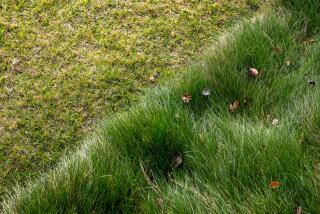Alternatives Sought to Chemical Sprays : Iowa Program Aims to Stamp Out Weeds
DES MOINES, Iowa — A weed is a weed is a weed to most people, but to roadside biologist Trelen Wilson the good weeds can be trained to go after the bad ones.
The noxious weeds, the ones he and other weed commissioners are required by law to stamp out, are the enemy since they compete with crops and plug up drain tiles.
The common method is to spray them with chemicals like 2,4-D. “We’ve been doing that for 30 years and it has not been successful,” said Wilson, roadside biologist for Story County. “What we’ve done is simply create 2,4-D-resistant thistle and snake grass.”
The good weeds to Wilson are the same plants that sodbusters turned under years ago to make way for farm fields: native prairie.
Prairie plants don’t wander into soybean fields, they’re excellent ground cover for wildlife and, like eager athletes, they can be trained to win.
“They’re well-behaved,” said Wilson. “They compete against misbehaved ones but they don’t cause trouble. They know their place.”
Given enough time, the prairie plants would defeat the misbehaved weeds--pigweed, lamb’s-quarters, foxtail, ragweed and other miscreants that thrive in places where the soil is disturbed.
“In a hundred years if you left everything alone, it would be prairie again,” said Wilson. “Maybe less if conditions were extremely dry,” which favors prairie.
But farmers don’t have that much time and since spraying hasn’t been very successful, Story and several other counties are trying the new approach of coaxing prairie plants to battle the noxious ones.
“Instead of the strong-arm technique, you use all the tools,” said Wilson. “You use nature instead of fighting it. You want the best-adapted plant community living in the ditches. Otherwise you’ll have weeds.”
Others in similar positions around Iowa are enthused about the prospect of prairie-versus-weed.
“We’re really excited about it,” said Lee County Engineer Dennis Osipowicz. “We were looking for another way to handle noxious weeds and brush. The board (of supervisors) doesn’t like spraying, and I’m not crazy about it either.”
“Everybody’s coming to the realization that chemicals aren’t the ultimate solution,” said Jackson County engineer Steve DeVries.
Still, roadside spraying is the rule in Iowa. All but nine of 91 counties responding to a 1986 survey do at least some spraying, and six still spray every ditch. But complaints from landowners, fears of pollution and cost of chemicals have driven several counties to try alternatives.
The problem with prairie is that it takes time to flourish and it needs regular maintenance, mainly a spring burn-off every other year or so to discourage woody pests and to rejuvenate the grasses.
Plus, prairies look different. To the untrained eye, prairies look ragged and weedy. Wilson says some residents can’t understand why the ditches simply aren’t mowed and manicured. Aside from the cost and man hours required, he explained, mowing doesn’t work much better than spraying. “It’s a disturbance and favors certain weeds.”
“We have to change the public’s ideas about the roadsides,” Wilson said. Instead of being on the defensive about odd-looking ditches, perhaps Iowa should follow Texas’ lead. Wilson said Texas has planted wildflowers in some ditches and proclaimed them to be a tourist attraction.
A feature of roadside ditches that makes them difficult to manage, Wilson said, is that they are often disturbed. Soil will either wash or blow in or sometimes the county engineer comes and scrapes it out, leaving bare soil.
Bare spots are fertile territory for fast-moving weeds and are no match for slow-going prairie, which is where Wilson and the other roadside experts come into play.
Lee County conservationist Bob Burchett says one of the key combinations is to blend cool and hot weather grasses, the first to get started in the spring and fall and the other to take hold during the dry months.
“Prairie forms a community that works well together. They’re stronger than the sum of the whole. They help one another,” Wilson said.
He said he’d like to plant prairie in 85% of Story County’s 950 miles of roadway ditches. If it works, there would be little for a roadside biologist to do. “I’d like to work myself out of a job in 10 years,” he said.
More to Read
Sign up for Essential California
The most important California stories and recommendations in your inbox every morning.
You may occasionally receive promotional content from the Los Angeles Times.









